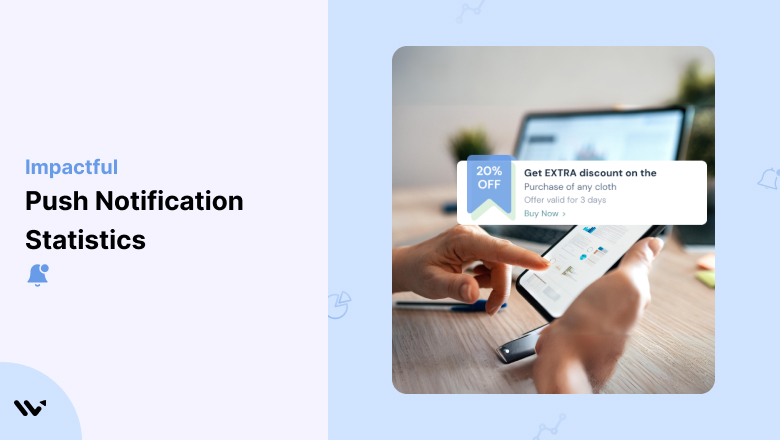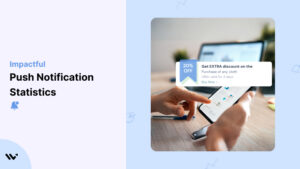Push notifications, or app notifications, have become commonplace on everyone’s screen.
These notifications allow marketers to attract more customers and increase traffic on their app or website.
Studies show that 88% of users were more engaged on an app platform and had a 12% click rate due to push notifications.
In this blog, we will look at key push notification statistics from recent years that can serve as a reference for the coming years.
Top Highlights
In the US, smartphone users get about 46 push notifications a day.
On phones and computers, 60% of people sign up for push notifications, while on tablets, it’s 10%.
eCommerce, media, and blogging businesses send the most push notifications, with almost 40% using them successfully.
Push notifications have high open rates, reaching up to 90%.
Business and finance notifications have the highest open rates at 5.46%.
About 28% of mobile app users who click on a push notification end up making a purchase.
Around 60% of people agree to receive push notifications.
Most people (95%) get push notifications through the Chrome browser.
On Android 13, the highest opt-in rate for push notifications was 74% in the BSFI sector in 2023.
Between 55% and 60% of app users agree to receive push notifications.
Build trust & FOMO
Highlight real-time activities like reviews, sales & sign-ups.
Key Push Notification Statistics
Push notifications are a part of daily mobile phone usage. All apps installed on our devices send push messages.
Here are some important stats about push notifications.
1. Tuesday sees the highest engagement for push notifications at 8.4%.
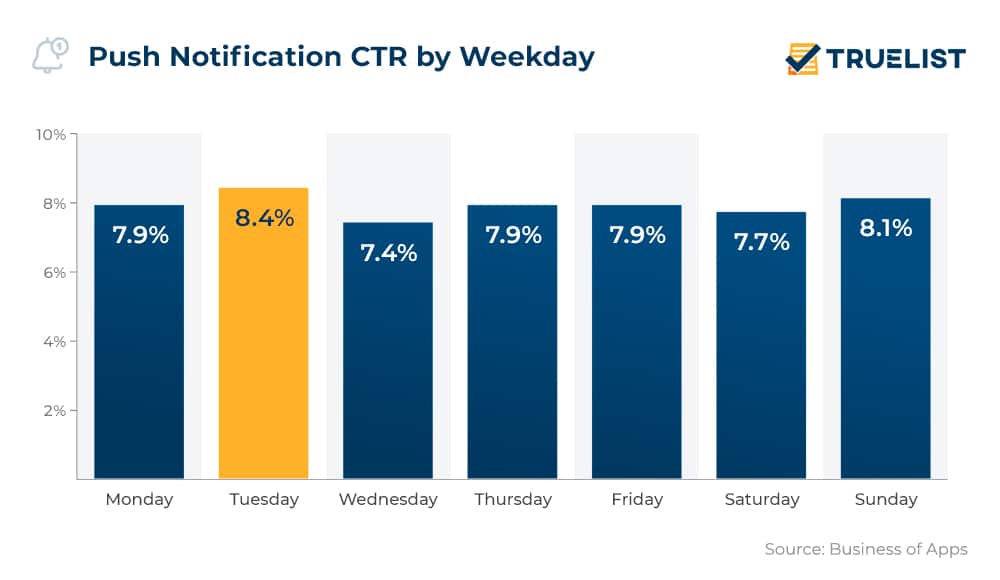
2. According to Business of Apps, An average smartphone user in the US receives at least 46 push notifications daily.
3. According to Avada, The Business and Finance industry enjoys the highest open rates at 5.46%.
This may be due to the relevance and urgency of this industry. The finance world goes through a lot of changes every hour, and to keep up with them, users opt for relevant apps and websites.
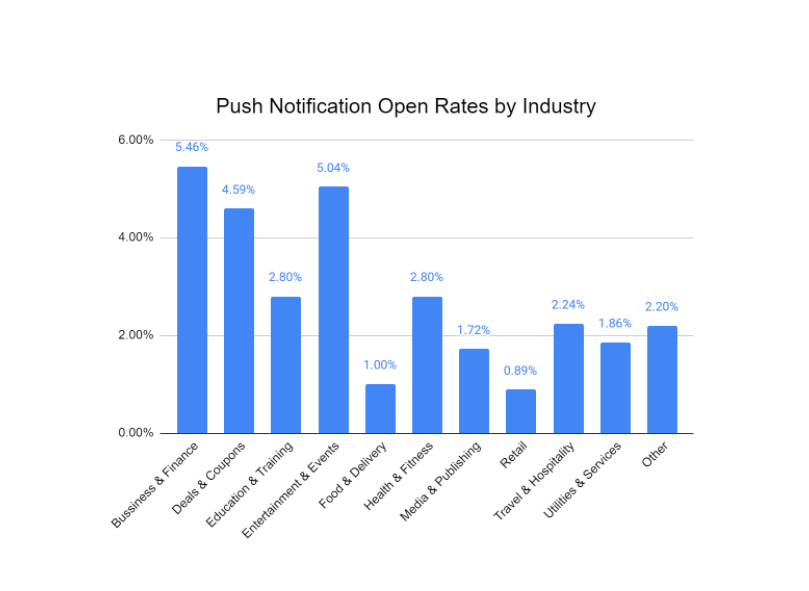
4. The Entertainment and Events industry enjoys 5.04% open rates.
This is mainly because people are always on the lookout for something interesting to watch and experience.
With the recent boost in global entertainment and regional titles being available globally, this industry has seen a boost in push notification open rates.
5. The Deals and Coupons industry has an open rate of 4.59%.
eCommerce is a growing sector in the business world, and along with it, so is the deals and coupons sector.
Consumers are constantly looking for good discount opportunities and thus are highly likely to opt into apps for this specific purpose.
6. Education and training, as well as the health and fitness industry, followed at 2.80%.
7. According to Moengage, push notification campaigns run on mobile devices and desktops enjoy 60% and 30% subscriptions, respectively, while tablet users contribute 10%.
8. According to Notifyvisitors, 28% of mobile app users who click on a push notification generally complete a purchase.
9. According to Avada, eCommerce Media and Blogging have the largest share in the push notification market, with almost 40% of businesses sending successful push notifications.
Also see: 10 Impactful Push Notification Example CTAs to Use
10. The average open rate for Android is 4.71%, whereas iOS has 4.72%.
11. According to Business of Apps, the overall push notification opt-in rate is around 60%.
12. According to Truepush, between 55% to 60% of app users consent to receive push notifications.
13. According to WorldMetrics, Push notification open rates can reach up to 90%.
‘Open Rate’ is the number of times app users have opened a received push notification.
14. The average open rate for push notifications is only 4%, according to Customer I/O.
Why are notifications opened or ignored?
Open rates are influenced by a variety of factors that affect the app user’s decision.
They are mainly based on what the broadcast messages are about when they are delivered, user preference, and technical influence.
Relevance
Push notifications place a lot of importance on the relevance of the messages.
Most are about current trending topics that the majority of users are interested in.
If the content of the notification is not relevant to the user, most push notifications are likely ignored and disabled.
Timing
The timing of the message is also important. Studying when most users are online and likely to view push notifications affects the click-through rate.
Studies show that mobile use peaks between 9 am and 7 pm.
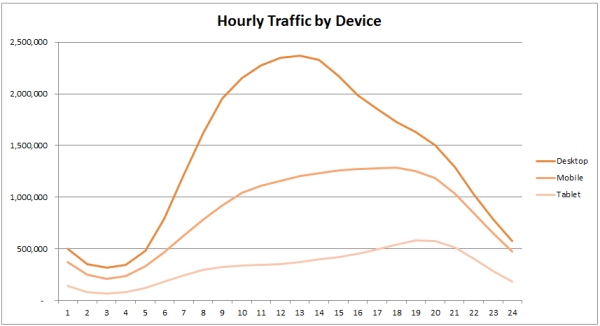
Personalization
Push notifications that cater to a user’s personal preference or needs are more likely to be opened.
In-app marketers need to analyze their target audience and create push notifications accordingly.
Build trust & FOMO
Highlight real-time activities like reviews, sales & sign-ups.
Technical Considerations
Mobile app users are very particular about their user experience.
If push notifications are difficult to navigate, they tend to be disabled, or the apps uninstalled.
Thus, Push notifications should ensure a smooth user interaction to enhance retention rates and encourage users to interact with the notification.
15. 65% of users return to the app when push is enabled.
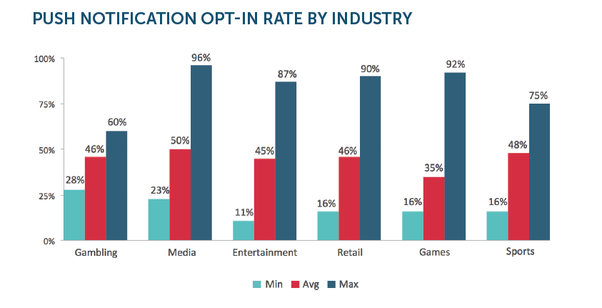
16. The media industry enjoys the highest opt-in rate of 96%, and the entertainment industry comes in second at 87%.
17. CTR for notifications with images was seven times higher than those with plain text.
Click-through rates are measured when a user engages with the notification in any form.
18. The Click Through Rate for push notifications is higher in Android at 13.6% as compared to iOS at 4.1%.
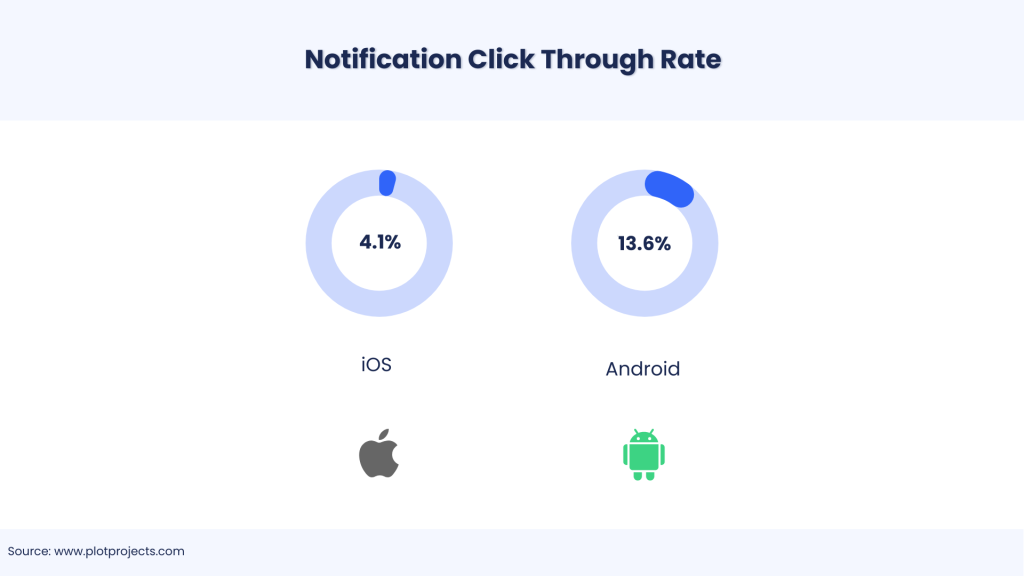
Understanding the Subscriber Churn
19. 26%Users who receive push notifications within three months of opting-in have 3 times higher retention rates.
20. 65% of users return to the app when push is enabled.
21. Studies show that a 5% increase in user retention can result in a 50% boost in a business’s value.
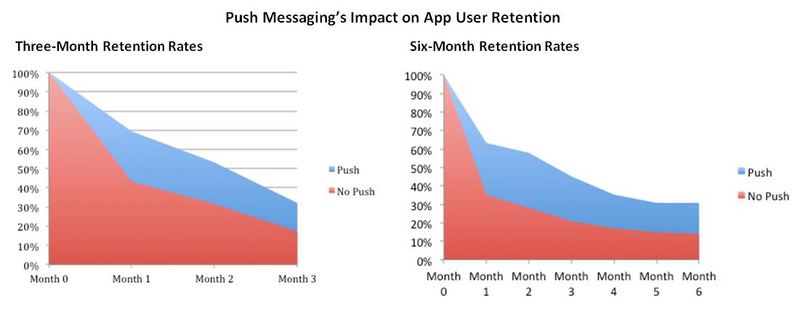
How Many Notifications Per Day?
24. In a study conducted by Loyalitics says that almost 50% of users find push notifications annoying. But the other 50% found them useful.
25. Consumers have always preferred fewer notifications.
A study reports that anywhere between 2 to 5 weekly push notifications can cause push notification subscribers to disable push notifications.
46% of users disable notifications, whereas 32% uninstall the app if they receive more than 6 notifications.
Build trust & FOMO
Highlight real-time activities like reviews, sales & sign-ups.
Push Notifications: Web and App
Push notifications can be web-based or app-based.
The main difference between these is that web-based push notifications are sent through your web browser, while app-based ones are sent through mobile apps.
26. 95% of all push subscribers receive notifications via Chrome
27. The sign-up rate among site visitors for push notifications is 5%-25%.
28. Mobile apps send notifications to almost 60% of users who installed them.
29. According to Notifyvisitors, almost 21% of app users abandon an app after a single use.
For web you can use social proof notification that will help build trust with your audience and increase conversion rates.
30. According to Digital Commerce 360, less than 50% of apps use notifications.
31. The total open rate on push notifications is 6% on Android, whereas iOS users are at 6.6%.
32. BSFI saw the highest opt-in on Android 13 at 74% as of 2023.
33. Around 73% of iPhone users and 95% of Android users opt-in to receive push notifications.
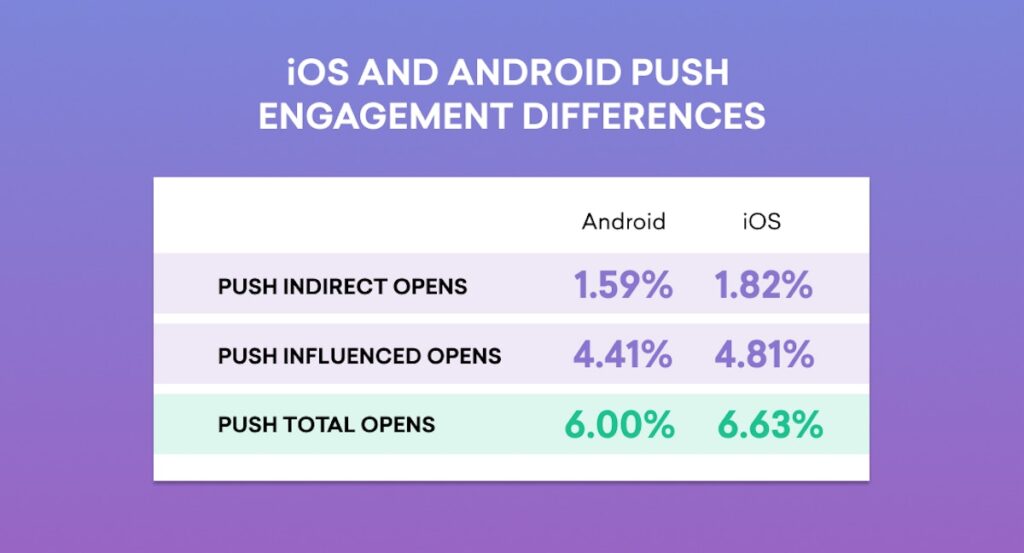
Wrap up
Push notifications are a valuable asset to businesses across sectors. If used effectively, they can draw in numerous profits and increase consumer engagement.
They can also increase visibility. Rich push notifications encourage high opt-in rates and app retention.
Moreover, push notification statistics indicate that users who receive many push messages are most likely to disable app push notifications.
Businesses should send push notifications according to user preferences to generate more traffic.
Sources
Business of Apps | Moengage | Customer I/O | Batch | RealEye | Helpshift | Loyaltics
